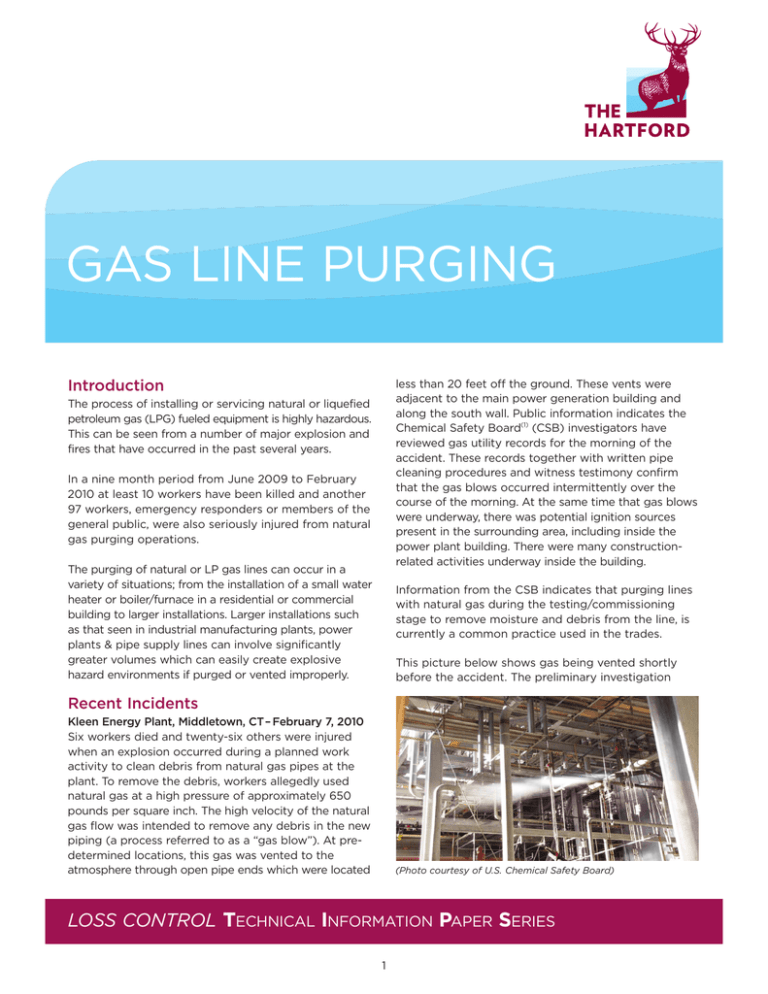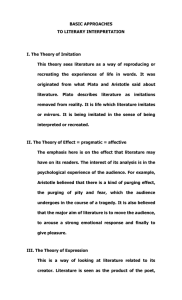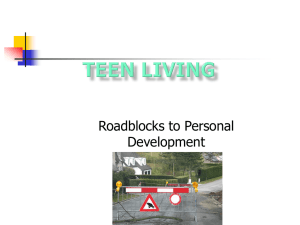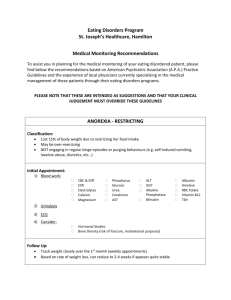
GAS LINE PURGING
less than 20 feet off the ground. These vents were
adjacent to the main power generation building and
along the south wall. Public information indicates the
Chemical Safety Board(1) (CSB) investigators have
reviewed gas utility records for the morning of the
accident. These records together with written pipe
cleaning procedures and witness testimony confirm
that the gas blows occurred intermittently over the
course of the morning. At the same time that gas blows
were underway, there was potential ignition sources
present in the surrounding area, including inside the
power plant building. There were many constructionrelated activities underway inside the building.
Introduction
The process of installing or servicing natural or liquefied
petroleum gas (LPG) fueled equipment is highly hazardous.
This can be seen from a number of major explosion and
fires that have occurred in the past several years.
In a nine month period from June 2009 to February
2010 at least 10 workers have been killed and another
97 workers, emergency responders or members of the
general public, were also seriously injured from natural
gas purging operations.
The purging of natural or LP gas lines can occur in a
variety of situations; from the installation of a small water
heater or boiler/furnace in a residential or commercial
building to larger installations. Larger installations such
as that seen in industrial manufacturing plants, power
plants & pipe supply lines can involve significantly
greater volumes which can easily create explosive
hazard environments if purged or vented improperly.
Information from the CSB indicates that purging lines
with natural gas during the testing/commissioning
stage to remove moisture and debris from the line, is
currently a common practice used in the trades.
This picture below shows gas being vented shortly
before the accident. The preliminary investigation
Recent Incidents
Kleen Energy Plant, Middletown, CT– February 7, 2010
Six workers died and twenty-six others were injured
when an explosion occurred during a planned work
activity to clean debris from natural gas pipes at the
plant. To remove the debris, workers allegedly used
natural gas at a high pressure of approximately 650
pounds per square inch. The high velocity of the natural
gas flow was intended to remove any debris in the new
piping (a process referred to as a “gas blow”). At predetermined locations, this gas was vented to the
atmosphere through open pipe ends which were located
(Photo courtesy of U.S. Chemical Safety Board)
LOSS CONTROL TECHNICAL INFORMATION PAPER SERIES
1
LOSS CONTROL TECHNICAL INFORMATION PAPER SERIES
Gas Line Purging
control the release of purged gases. The purged fuel
gas was vented indoors into the utility room, which
was ventilated by an exhaust fan. Over 200 people
who had no role in the installation were in the building
when the natural gas found an ignition source and
exploded at approximately 11:25 a.m.
report from the U.S. Chemical Safety and Hazard
Investigation Board (CSB) indicate the explosion was
the result of venting a significant volume of natural
gas (estimated at 400,000 cubic feet of gas) to the
outdoors, but within an employee work area, during
the purging of the main gas line. Any ignition source
present (i.e. welding, portable heaters, electrical
equipment, static electricity, etc.) would be able to
initiate the explosion.
Other Similar Incidents
• During the construction of a 30 story hotel in 2008
in San Diego, an explosion injured 14 workers and
damaged 3 levels of the building. CalOSHA cited a
contractor for not venting from an enclosed space
and failure to test for flammable gases.
ConAgra Slim Jim Plant, Garner, NC – June 9, 2009
A major natural gas explosion heavily damaged the
ConAgra Slim Jim meat processing factory in Garner,
North Carolina. Four workers died in the resulting
explosion & building collapse, there were at least 71
injuries and a large section of the building collapsed.
Approximately 18,000 pounds of ammonia was
released causing an evacuation of personnel. This
release also resulted in a toxic exposure to emergency
response personnel and the general public. Resulting
environmental damage occurred from the large
ammonia release.
• In 2007 two plumbers in Cheyenne, WY were
severely burned during the purging of natural gas
into the interior of a new hotel under construction.
The workers stated they were unable to smell the
“odorized” gas as it filled the room.
• In 1999 at a Ford power plant in Dearborn, MI six
people were killed, 38 injured and $1 billion in property damage occurred. A gas pipe being removed
from service was purged into a boiler.
• 1997 in Cary, NC a worker attempted to purge air
from a natural gas line into a laundry room during a
startup of a commercial dryer. Six workers injured,
and a partial roof collapse occurred.
Problem Identified
• The purging of lines with natural gas during the
testing/commissioning stage to remove moisture
and debris (known as gas blows) from the line, is
currently a common practice used in the trades.
Many times this gas may be vented into interior or
restricted spaces that do not allow the gas to freely
disperse that result in a concentration buildup.
CONAGRA PLANT, GARNER, NC
(Photo courtesy of U.S. Chemical Safety Board)
• During the “firing” of equipment fueled by natural
or LP gas it is common to purge the fuel supply line
near the equipment. This often results in flammable
gas being vented in an enclosed area as the air is
purged from the line. These locations are typically
confined and have many potential ignition sources.
The accident occurred during the installation of a new
fuel gas-fired industrial water heater in an interior utility room of the plant. Five days prior to the accident, a
new section of three-inch steel piping – which would
provide natural gas to the heater – was tied into a sixinch natural gas supply line located on the roof. The
new natural gas piping ran horizontally over 120 feet
along the roof and then descended into the utility
room. The water heater manufacturer, was attempting
to purge the new gas line by using natural gas to
directly displace the air. This was done by removing
threaded fittings, creating one or more pipe openings
near the heater. The worker then opened a valve to
• Historically workers have relied on the sense of smell
to be able to detect the presence of the flammable
gas. A chemical odorant (T-butyl mercaptan) is
typically manually added to natural and LP gas.
However, perception can be subjective, and some
individuals can become desensitized after prolonged
exposure (resulting in the inability to recognize the
2
LOSS CONTROL TECHNICAL INFORMATION PAPER SERIES
Gas Line Purging
odor). In addition the effect of “odor fade” is now
being recognized. This can occur on new pipe
installations and can react to remove the odorant
effectiveness. The odorant manually added during
the distribution process has the potential to be
omitted by human error.
Emergency Actions
Following the ConAgra explosion investigation the
CSB in September 2009 issued a Safety Bulletin
entitled Dangers of Purging Gas Piping into Buildings.
Five key lessons learned were identified in this bulletin:
1. Purging new or existing gas piping into buildings
can be highly hazardous due to the possible accumulation of gas above the lower explosive limit
(LEL)(3) and the associated danger of fire and explosion. Wherever practicable, directly vent purged
gases to a safe location outdoors, away from people and ignition sources. This can be done using a
temporary hose or piping or permanently installed
vent pipes, depending on the facility design.
• All potential ignition sources are not effectively isolated or at times these sources can not be isolated
(i.e. static electricity or lightning).
• The recognition of the inherent hazards of gas
purging operations has been weak as evidenced by
number of explosion incidents in recent years.
• The current regulatory codes do not adequately
address the required safety measure when purging
newly installed, modified or serviced fuel gas systems.
2. Purging indoors should only be done in limited
circumstances where purging outdoors is not
practicable. In such cases:
Regulatory Standards/References
• Nonessential personnel should be evacuated;
The regulatory standards that apply to the installation
of natural and LP gas installation are covered under
voluntary consensus codes developed by several
organizations. These codes are commonly adopted as
regulations by various states or local municipalities
across the United States. The agency/associations and
codes are shown below:
• All ignition sources should be controlled or
eliminated;
• Ventilation should be adequate to maintain the
gas concentration well below the lower explosive
limit at all times.
• The National Fire Protection Association (NFPA)
publishes the National Fuel Gas Code (NFPA 54/
ANSI Z223.1).
3. Never rely on odor alone to detect releases of fuel
gases. An odorant(4) is typically added to fuel gases,
such as natural gas and propane, to warn workers
and consumers of releases. However, the perception
of odor is highly subjective and varies from one
person to another. People also become desensitized
to odor during prolonged exposures. Additionally,
new gas pipes and containers can react with or
otherwise remove the odorant, an effect known as
“odor fade.”
• The American Gas Association (AGA) publishes a
technical guide entitles Purging Principles and
Practice.
• The NFPA and AGA jointly publish the National Fuel
Gas Code Handbook.
• The International Code Council (ICC) also has the
International Fuel Gas Code.
4. Always use combustible gas detectors(5) to monitor
the gas concentration during purging operations. To
provide the most accurate information about combustible gas levels, sampling should be conducted
frequently or continuously at appropriate locations.(6)
Additional Mandatory Standards apply to industry
under the Occupational Safety and Heath Administration,
such as:
• Occupational Safety and Heath Administration
(OSHA) regulates LPG under 29 CFR 1910.110.
5. Ensure personnel involved in gas purging operations are fully trained and knowledgeable about safe
gas venting practices, the proper use of gas detectors, and the danger of relying on the sense of smell
alone to detect gas releases. Include training on the
problem of odor fade in new gas piping systems.
• OSHA also regulates flammable gases under 29 CFR
1910.119 where processes involve a flammable liquid
or gas on site in one location, in a quantity of 10,000
pounds or more.(2)
3
LOSS CONTROL TECHNICAL INFORMATION PAPER SERIES
Gas Line Purging
On February 4, 2010 just three days before the Kleen
Energy Plant explosion, the CSB voted to approve 2
urgent recommendations that national fuel gas codes
be changed. These changes are needed to improve
safety when gas pipes are being purged (cleared of
air) during maintenance or installation of new piping.
2009-12-I-NC-UR2
Incorporate the revised gas purging provisions of
the National Fuel Gas Code, consistent with CSB recommendation 2009-12-I-NC-R1, into the International
Fuel Gas Code.
On February 24, 2010 a NFPA panel voted to move
forward with the CSB’s recommendations to make gas
purging practices safer. Currently the National Fuel
Gas Code Committee has not approved the language
for a temporary interim amendment (TIA). The committee is working towards consensus language and
expects to release a draft TIA for public review in the
near future.
The first recommendation was directed to the National
Fire Protection Association (NFPA), the American Gas
Association (AGA) and the Chair of the NFPA 54/ANSI
Z223.1 Committee.
2009-12-I-NC-UR1
Enact a Tentative Interim Amendment as well as permanent changes to the National Fuel Gas Code (NFPA
54/ANSI Z223.1) to require that during the purging of
fuel gas piping at industrial, commercial, and public
facilities:
Lessons Learned
Training
All personnel should be properly trained in:
1. Lockout-Tagout
2. Safe Gas Purging Techniques
3. Hazard Identification
4. Use of Gas Monitoring Equipment
a. Purged fuel gases shall be directly vented to a
safe location outdoors, away from personnel and
ignition sources
b. If it is not possible to vent purged gases outdoors,
purging gas to the inside of a building shall be
allowed only upon approval by the authority having
jurisdiction(7) of a documented risk evaluation and
hazard control plan. The evaluation and plan shall
establish that indoor purging is necessary and that
adequate safeguards are in place such as:
Lockout – Tagout
1. Any potential ignition source should be identified
and isolated in the proximity of the work area. All
flames or potential ignition sources within proximity
should be de-energized and locked out. Use the
standard lockout-tagout protocols required under
OSHA 1910.
• Evacuating nonessential personnel from the
vicinity of the purging;
2. Just closing and locking out the fuel line may not
be enough. Has the line been purged of the fuel
gas inside. (see purging section on page 5)
• Providing adequate ventilation to maintain the
gas concentration at an established safe level,
substantially below the lower explosive limit; and
3. Fuel supplies in some cases upstream may also
need to be secured and locked out. This may also
require the installation of blinds in the fuel supply
line in some situations.
• Controlling or eliminating potential ignition
sources.
c. Combustible gas detectors are used to continuously monitor the gas concentration at appropriate
locations in the vicinity where purged gases are
released.
(SPADE BLIND WITH LOCKOUT DEVICE)
d. Personnel are trained about the problems of odor
fade and odor fatigue and warned against relying
on odor alone for detecting releases of fuel gases.
The second recommendation was directed to the
International Code Council (ICC) and the Chair of the
International Fuel Gas Code Committee.
BLANK (OR BLIND)
4
LOSS CONTROL TECHNICAL INFORMATION PAPER SERIES
Gas Line Purging
The Tentative Interim Amendment (2009-12-I-NC-UR1)
issued by the Chemical Safety Board states that if it is
not possible to vent flammable gas outside then it
shall only be allowed when approved by the Authority
Having Jurisdiction(7) of a documented risk evaluation
and hazard control plan. If it is not possible to purge
to a safe outside location then interior purging should
only be done with very careful planning.
Purging
1. Gas blows (or the purging) of pipe to remove
contaminant or debris should be done using nonflammables that are inert such as air (not pure
oxygen), carbon dioxide or nitrogen. This reduces
the risk of fire or explosion. These gas blows have
risks associated:
• Possible high pressure discharges to clean out
the line. Where is the discharge point? This point
should be located in an isolated area away from
contact with personnel, equipment and buildings.
• Develop a written Purging Plan that addresses:
– Employee training
– Lockout-tagout of ignition sources and fuel
source minimization
– The purging process
– Monitoring of flammable gases (and oxygen levels)
– Minimizing exposure to non-essential personnel
– Evacuation/emergency response
• These discharges should be outside in a well
ventilated area that allows quick dispersion of
gas concentration or buildup.
• Caution needs to be used with inert gases.
Nitrogen can be used to reduce the risk of fire
or explosion but it also can make the atmosphere
in and around the equipment hazardous for
humans to breathe(7). It’s not toxic as it makes up
78% of the air we breath but it can displace the
air we breathe as the inert concentration levels
rise. If the concentration of oxygen is reduced to
below 19.5% a person could become unconscious
and die from lack of sufficient oxygen.
• Have the written plan reviewed and approved by the
Authority Having Jurisdiction.
Hazard Identification
Break down the purging task to identify all potential
hazards by a job hazard analysis (JHA) process.
3 steps are involved in the development of a JHA.
(see attachment)
• High pressure gas blows or purging can cause
catastrophic failure of pipe, valves or fittings.
Pipe, valves, fittings, gauges, etc. should all be
designed for the pressures that are intended. If
not, precautions need to be taken to keep the
pressures within design parameters or to isolate
(i.e. via the installation of line blinds or blanks).
1. Creating a step by step task analysis to complete
the job.
2. Identify all the potential hazards associated with
each task step.
3. List the methods of control for each of the hazards
identified.
2. When purging of pipe for the purpose of displacing
air or other gas within the pipe and replacing it
with fuel gas (natural or LP) extreme caution is
required due to the fuel gas that is charged into the
system escaping into the atmosphere. This purging
should be directed outdoors in a well ventilated
space that is free from all ignition source hazards.
Monitoring
Checking
for layers
of gas
at various
levels
• A temporary pipe or hose could be used to
purge from the source to a safe outside area.
When locating the purge discharge take into
consideration the physical properties of the gas
being purged.
• For gas heavier than air consider low spots or
depressions where heavier gas vapors will settle.
Consider the effects of weather on dispersion of
the gas being purged. The gas should be rapidly
dispersed and not exceed 10% of the LEL.
Whether performing a
gas blow or a purging
operation (inside or outside) with flammable gas
a potential exists for an
accumulation of gas at
an explosive level. The
only safe means to monitor for flammable gas
concentrations is with a
reliable combustible gas
detector(6).
Combustible gas detectors should be rated
intrinsically safe by a
5
LOSS CONTROL TECHNICAL INFORMATION PAPER SERIES
Gas Line Purging
5. Combustible gas detectors measure combustible/
flammable gas concentration in the atmosphere,
which is indicated on the device as a percentage of
the lower explosive limit (LEL).
certifying organization such as Underwriters
Laboratory (UL®) or Factory Mutual (FM®). They also
should be calibrated and serviced per the manufacturer
instructions. Employee training in the proper use of
this equipment is required. Following the manufacturer’s
instructions is crucial to hazard identification.
6. The evaluation of appropriate locations for combustible gas monitoring should include consideration
of the purge location, characteristics of the gas
(lighter or heavier than air), stratification or mixing
of the gas, and existing ventilation. See the
International Society for Automation (ISA) RP 12.13,
Recommended Practice for the Installation,
Operation, and Maintenance of Combustible Gas
Detection Instruments (2003) and the American
Petroleum Institute (API) 2009, Safe Welding,
Cutting, and Hot Work Practices in the Petroleum
and Petrochemical Industries (2002).
Testing should be done frequently and at predetermined locations during the purging process. At any
time if the gas concentration exceeds 10% of the LEL,
the purging process should be immediately stopped.
For More Information
For additional information specific to your need,
please contact your Hartford loss control consultant,
or visit us at www.thehartford.com.
7. The NFPA defines the Authority Having Jurisdiction
(AHJ) as an “organization, office, or individual
responsible for enforcing the requirements of a
code or standard, or for approving equipment,
materials, an installation, or a procedure” such as a
local fire marshal or building official. NFPA 654,
Standard for the Prevention of Fire and Dust
Explosions from the Manufacturing, Processing, and
Handling of Combustible Particulate Solids, 2006
Edition, 654-6. Where it is not possible to implement safety controls, NFPA standards can grant
decision-making authority over exceptions to safety
requirements to the authority having jurisdiction.
Footnotes
1. The Chemical Safety Board (CSB) is an independent federal agency charged with investigating
industrial chemical accidents. The CSB conducts
root cause investigations of chemical accidents at
fixed industrial facilities.
2. Except for hydrocarbon fuels used solely for workplace consumption as a fuel (e.g., propane used for
comfort heating, gasoline for vehicle refueling), if
such fuels are not a part of a process containing
another highly hazardous chemical covered by 29
CFR 1910.119.
3. The LEL, also known as the Lower Flammable Limit
(LFL), is defined as “that concentration of a combustible material in air below which ignition will not
occur.” Recommended Practice for Handling
Releases of Flammable and Combustible Liquids
and Gases, NFPA 329 (2005).
8. CSB identified 85 nitrogen asphyxiation incidents
that occurred in the workplace between 1992 and
2002. Eighty people were killed and 50 were
injured. Source USB Safety Bulletin No. 2003-10-B |
June 2003
4. Natural gas is primarily composed of methane, an
odorless and colorless gas. In order to heighten
an individual’s ability to detect natural gas, small
quantities of odorant are added. T-butyl mercaptan
(typically described as having a “skunk-like” odor),
is one such odorant.
Sources
Various U.S. Chemical Safety Board, available public
Investigation and Safety Bulletin information
The information provided in these materials is intended to be general and advisory in nature. It shall not be considered legal advice. The Hartford
does not warrant that the implementation of any view or recommendation contained herein will: (i) result in the elimination of any unsafe conditions
at your business locations or with respect to your business operations; or (ii) will be an appropriate legal or business practice. The Hartford
assumes no responsibility for the control or correction of hazards or legal compliance with respect to your business practices, and the views
and recommendations contained herein shall not constitute our undertaking, on your behalf or for the benefit of others, to determine or warrant
that your business premises, locations or operations are safe or healthful, or are in compliance with any law, rule or regulation. Readers seeking
to resolve specific safety, legal or business issues or concerns related to the information provided in these materials should consult their
safety consultant, attorney or business advisors. All information contained herein is as of September 2011.
© September 2011 The Hartford Financial Services Group, Inc., Hartford, CT 06155 All Rights Reserved
6
LOSS CONTROL TECHNICAL INFORMATION PAPER SERIES
Gas Line Purging
PURGING JOB HAZARD ANALYSIS
TASK NAME:
LOCATION:
DATE:
EQUIPMENT BEING PURGED:
TASK STEP
HAZARD
7
CONTROL
LOSS CONTROL TECHNICAL INFORMATION PAPER SERIES
Gas Line Purging
PURGING CHECKLIST
The below sample checklist is not all-inclusive and should be used as a means to help monitor your worksite.
YES
Has a Purging – Job Hazard Analysis been completed?
Have all fuel line sources been identified?
Have all fuel lines not required for the purging operation
been secured and locked out?
Are line blanks or blinds required to safely isolate fuel lines,
fitting, gauges?
Is the purging discharge line located outside away from
personnel, equipment & buildings? If No, a written Gas Purging
Plan should be developed.
Could high pressure discharge direct gases or foreign objects
towards personnel, equipment & buildings?
Is inert gas being used as the purging medium? If Yes
a.) Will oxygen levels be monitored to maintain adequate
concentration between 19.5% and 23.5%?
Will purging operation involve a flammable gas?
Will the flammable gas purged settle into low areas where
there are uncontrolled ignition sources?
Has the written Gas Purging Plan been communicated to
and approved by the local Authority Having Jurisdiction?
Have all non-essential personnel been evacuated to a safe
location from the purging operations?
Are reliable combustible gas meters being used to sample
for gas concentrations?
Have employees using the combustible gas meters been
trained on their use?
Have the combustible gas meters been properly calibrated
and tested per the manufacturer specifications?
Have all employees been specifically trained in safe procedures
for the gas purging operations?
Is a temporary hose or line required to direct the purged gas
to safe locations outside of the building?
Has emergency response personnel (Fire Department, EMS, etc.)
been notified of the gas purging activities planned?
Are additional ventilation sources required to maintain gas
concentrations within acceptable levels?
Have all potential ignition sources been isolated, de-energized
and locked-out?
COMPLETED BY:
DATE:
8
NO
NOTES






